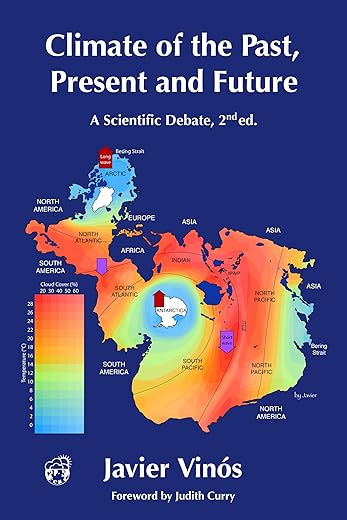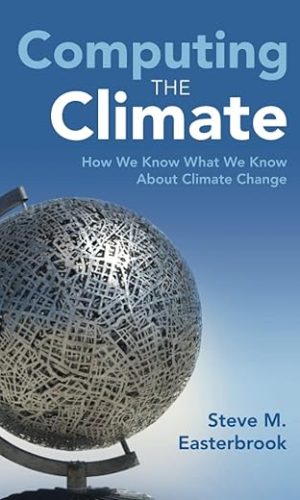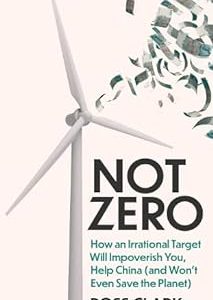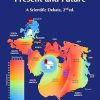Climate of the Past, Present and Future: A scientific debate, 2nd ed.
£3.20
This book is an unorthodox ground-breaking scientific study on natural climate change and its contribution to ongoing multi-centennial global warming. The book critically reviews the effect of the following on climate:
– Milankovitch cycles
– abrupt glacial (Dansgaard-Oeschger) events
– Holocene climate variability
– the 1500-year cycle
– solar activity
– volcanic eruptions
– greenhouse gases
– energy transport
Applying the scientific method to available evidence reveals that some of these phenomena are profoundly misunderstood by most researchers. Milankovitch cycles are tied to orbital obliquity, not to orbital precessional summer insolation; glacial megatides might have triggered abrupt Dansgaard-Oeschger events; and tides are likely responsible for the related 1500-year climate cycle. Climate change affects volcanic eruptions more than the opposite; and secular variations in solar activity are more important to climate change during the Holocene than greenhouse gases. In this book, we see how important natural climate change has been on human societies of the past. It also produces new climate projections for the 21st century and when the next glaciation could happen. What emerges from this study of natural climate change is a central theme: Variations in the transport of energy from the tropics to the poles have been neglected as a cause of climate change, and solar activity variations affect climate by modulating this transport. The author tells us: -Transporting more energy from a greenhouse gas-rich region, the tropics, to a greenhouse gas-poor region, the poles, increases the amount of energy lost at the top of the atmosphere. The effect resembles a reduction in the greenhouse gas content.- The book presents the Winter-Gatekeeper Hypothesis on how variations in solar activity regulate Earth’s energy transport and in so doing affect atmospheric circulation, the rotation of the planet, and the El Niño/Southern Oscillation. This book is oriented toward students and academics in the climate sciences and climate anthropology and should also appeal to readers interested in the science of natural climate change. The repercussions of Climate of the Past, Present and Future are far reaching. By uncovering a strong natural climate change component, it provides a novel view of anthropogenic climate change, fossil energy use, and our future climate; a view quite different from the IPCC’s gloomy projections.
– Milankovitch cycles
– abrupt glacial (Dansgaard-Oeschger) events
– Holocene climate variability
– the 1500-year cycle
– solar activity
– volcanic eruptions
– greenhouse gases
– energy transport
Applying the scientific method to available evidence reveals that some of these phenomena are profoundly misunderstood by most researchers. Milankovitch cycles are tied to orbital obliquity, not to orbital precessional summer insolation; glacial megatides might have triggered abrupt Dansgaard-Oeschger events; and tides are likely responsible for the related 1500-year climate cycle. Climate change affects volcanic eruptions more than the opposite; and secular variations in solar activity are more important to climate change during the Holocene than greenhouse gases. In this book, we see how important natural climate change has been on human societies of the past. It also produces new climate projections for the 21st century and when the next glaciation could happen. What emerges from this study of natural climate change is a central theme: Variations in the transport of energy from the tropics to the poles have been neglected as a cause of climate change, and solar activity variations affect climate by modulating this transport. The author tells us: -Transporting more energy from a greenhouse gas-rich region, the tropics, to a greenhouse gas-poor region, the poles, increases the amount of energy lost at the top of the atmosphere. The effect resembles a reduction in the greenhouse gas content.- The book presents the Winter-Gatekeeper Hypothesis on how variations in solar activity regulate Earth’s energy transport and in so doing affect atmospheric circulation, the rotation of the planet, and the El Niño/Southern Oscillation. This book is oriented toward students and academics in the climate sciences and climate anthropology and should also appeal to readers interested in the science of natural climate change. The repercussions of Climate of the Past, Present and Future are far reaching. By uncovering a strong natural climate change component, it provides a novel view of anthropogenic climate change, fossil energy use, and our future climate; a view quite different from the IPCC’s gloomy projections.
Read more
Additional information
| Publisher | Critical Science Press (20 Sept. 2022) |
|---|---|
| Language | English |
| File size | 95954 KB |
| Text-to-Speech | Enabled |
| Enhanced typesetting | Enabled |
| X-Ray | Not Enabled |
| Word Wise | Enabled |
| Sticky notes | On Kindle Scribe |
| Print length | 740 pages |






by Lifeman
Climate of the Past, Present and Future presents scrupulous analysis of historical climate changes, shown attributable to fluctuations of planetary orientation and galactic transition, most significantly with a contribution from greenhouse gas no greater than 3%. Its scientific rigour offers solid authentication for the growing body of literature exposing the fallacy of human influence on climate, offering hope that the inevitable emergence of truth is in sight
by Adrian Ryan
Vinós’s book is entitled ‘Climate of the Past, Present and Future: A scientific debate’, but for Vinós, there is no debate: solar variability is a much larger forcing on global temperatures than carbon dioxide, and the mechanism is variability in the ultra violet band of solar radiation through the solar cycle, which heats stratospheric ozone creating temperature gradients that control the transport of warm air to the poles which radiate heat out into space. Vinós’s argument is well-reasoned and persuasive; it accounts, for example, for the striking correspondence of grand solar minima with periods of cooler climate. This is an important book, and I highly recommend it.
by Stu
Very interesting and very relevant to today’s changing weather patterns.
by John
“It’s all your fault,and unless we (you) change our (your) ways,we’re doomed,all doomed!!”
How often have we heard that mantra repeated? Well it’s not that simple,and this excellent work by Javier Vinos will explain in great detail that it is a very complex subject,and that Earth’s climate is governed by forces far beyond our control.
This is not an easy read,in part due to it’s sheer length and complexity,but also due to the extensive use of abbreviations throughout. These abbreviations are explained in the opening pages,and here is a tip for Kindle readers,make a note of those abbreviations before you start reading and it will make life much easier than keep having to refer back.
Read this excellent book and I feel sure that you will see the whole issue of Climate Change in a new light.
Far from being “doomed”,climatic variations have been happening since the beginning of time;life on Earth,Mankind included, simply learns to adapt.
by Daymar64
Very Technical and educational. Gives me ammunition when I discuss Global Warming with a sceptic.
by N. P. Record
Climate change has become emotive to the point of religious. This book, written by a ‘neutral’, is a very detailed review of the history of the planet’s climate, essentially a compilation and summary of a huge raft of academic papers. It’s dense; it’s not a bedtime read, but if you are serious about understanding the Climate, then it’s a must.
by Ms. J. Cooper
A brilliant review of the best known evidence available to us about the science instead of the usual hysterical and childish nappy wetting clap trap
by Ian J Cook
I have found the review of evidence and conclusions drawn to be both fascinating and enlightening. Thank you for an enjoyable debate and for much food for thought.